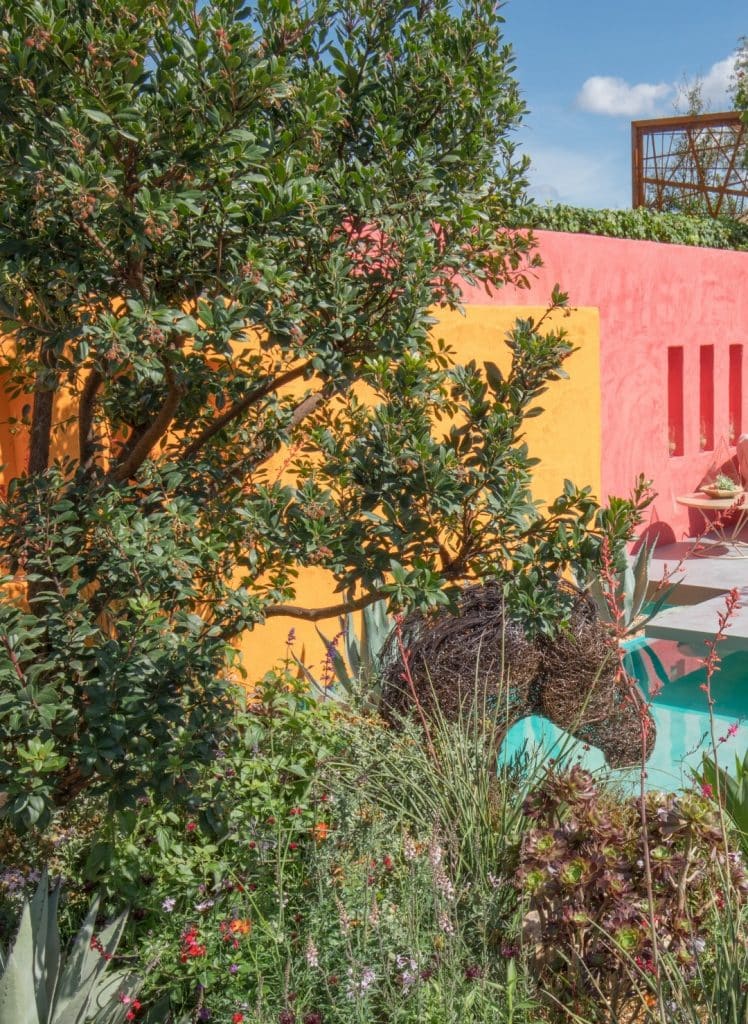Trees For Small Gardens
When I created my garden ‘Beneath a Mexican Sky’ at the Chelsea Flower Show in 2017, I clearly remember the moment the space became a garden. It was when the first tree was planted that I had this overwhelming feeling that a blank space with walls on two sides had been transformed into a living, breathing space. Trees and plants make a garden. The hard landscaping is complimentary. Whether you have a small city garden, a London courtyard, a roof garden, suburban garden a rural space or a Mediterranean garden abroad, they all should have trees.
As a landscape and garden designer working in North London and Hertfordshire, I often get asked “Could you recommend a tree for a small garden?”. It led me to write a blog about ‘Trees for Small Gardens’.
Prunus serrula var. tibetica is a stunning tree. It provides interest through every season. Here seen growing in a large granite pot. It can be grown as a multi-stem or a standard tree.

Photo Credit: Inland Homes Plc
CHOOSING A SMALL TREE
We all get attracted by beautiful looking plants in a nursery. Often, we make the purchase without any thought to how tall the plant will grow and how wide it will spread. It is worth doing some research especially when it comes to trees for a small garden. When choosing a tree find out the height at maturity, how long it takes to reach the ultimate height and what the canopy spread could be. Without this information there could be potential problems in the future. The tree could grow so big that it dominates and dwarfs the space, it blocks out light for you and possibly your neighbour. This can lead to neighbourly disputes. The tree could potentially cause damage to the foundations of your house. The best time to plant a tree is when it is dormant, and the leaves of deciduous trees have fallen. This is from late autumn through to end of winter. The tree will suffer less stress and settle into its new home quicker provided a good watering regime is adhered to.

There has been a real surge in homeowners growing fruit trees through the pandemic. If you have a limited space, one way you can grow fruit trees is by training them as an espalier against a wall or a fence. Espalier fruit trees come pre-trained, or you can have a go yourself.
PRIVACY
Often with small suburban and city gardens privacy is an issue. Using trees is the best way to create screening. Pleach trees are very good for screening. They provide a green screen at a higher level. Pleach trees are available in a variety of different species both as evergreen and deciduous forms. For evergreen pleach look at Prunus lusitanica or Quercus ilex. For deciduous pleach I would recommend Carpinus betulus (Hornbeam) or Fagus sylvatica (Beech). Both Hornbeam and Beech hold the autumn leaves for a long time and the autumn colours are a pure delight. Growing a row of small multi-stem trees can also provide screening. Pleach and Cube headed trees are a perfect choice for contemporary gardens and they can be maintained at their formed size.
FRUIT TREES
Through the pandemic the sale of fruit trees has shout through the roof. If you have a small garden and want to grow fruit trees, think about training the fruit trees as espaliers against a wall or a fence. You can train the branches horizontal, as a candelabra, a fan or as a lattice. Nowadays there are many varieties of dwarf fruit trees on the market. Fruit trees are even being sold as pillars and these can be grown in containers so ideal for a balcony garden, roof garden or a courtyard garden. The choice of fruit trees is endless. Some of the popular varieties are conference pears, red sentinel apples, morello cherry and plums. If you are only growing one fruit tree, then you might want to think about growing one that is self-fertile.
There is so much more to trees than just the leaves and the flowers. When choosing trees, look at the branch structure, the patterns, and textures of the bark. Here we have a beautiful Acer griseum commonly known as the Paper Bark Maple. The peeling bark provides added interest to this tree.

CHOOSING TREES FOR INTEREST
When choosing a small tree for a small garden look at the branch structure. Will it be pleasant to look at in winter when all the leaves have dropped off? Is there bark interest. Some trees have colourful bark. I particularly like the trees with peeling or patterned bark.
What sort of autumn colour does the tree provide? Does the tree bear flowers, are they fragrant, do these turn into berries?
Amelanchier lamarckii is a tree that is often used by London garden designers. I tend to prefer it as a multi-stem tree. It has a beautiful delicate open canopy. In spring the tree gets covered in small star shaped white flowers. As the flowers fade, new leaves appear in a pinky copper tone, maturing to green. The flowers will produce red berries. The birds love feeding on these making Amelanchier a choice tree for a wildlife garden. The autumn colour is spectacular.

Amelanchier lamarckii is the go-to tree for many garden designers. It has delicate open canopy. I tend to grow this as a multi-stem tree. It gets covered in an abundance of small starry white flowers in spring followed by the coppery pink leaves of the new season. The autumn colour is wonderful, and the berries will attract birds.
Prunus serrula var. tibetica is another exceptional tree for a small garden. This is another that I like to grow as a multi-stem. It provides interest throughout the year. The polished red bark looks as if it has copper wires wrapped around it. It produces clusters of white blossoms. The leaves turn a golden yellow in autumn. One can enjoy the branch structure and the bark in the low winter sun.
Acer griseum (Paperbark Maple) is a stunning tree that I have recently planted in my own garden. This tree is the one you want to plant for winter interest. On a mature tree the cinnamon-coloured bark will peel and curl whilst still attached to the tree. It gives fireworks display of colour in autumn from pinks to fiery reds.
SMALL TREES FOR MEDITERRANEAN GARDENS
Arbutus unedo (Strawberry tree) is a beautiful tree. If you want to create a Mediterranean garden this is a tree to be considered. It is has lovely strong branch structure and being evergreen it provides interest all year round. It has bright red fruit in autumn and is an excellent tree for pollinators and birds. Arbutus unedo is a good tree for coastal gardens too. Another relative and one of loveliest small trees is Arbutus x andrachanoides. A mature tree has gnarled stems. The bark also turns an orangey cinnamon colour that peel. White flowers in autumn will turn into red fruit in spring.

My garden Beneath a Mexican Sky at the Chelsea Flower Show incorporated multi-stem Arbutus unedo. It is a tree that is well worth consideration for a small garden. An evergreen tree that will flower in November and produce fruit in spring.
Perfect for a Mediterranean garden.
Olea europea (Olive tree) is the perfect small tree for a Mediterranean garden. They are hardy in the UK and because they have small greyish green leaves that are waxy, they do not suffer so much water evaporation making them a good choice for roof gardens. I have planted six mature trees on a roof garden in Hampstead, North London that are thriving. They are good trees for coastal gardens too. In the UK they will flower, and some will possibly produce fruit but nothing that will give you harvest. The most characterful trees are the ones with the gnarled trunks. Olive trees can also be cloud pruned.
SMALL TREES FOR JAPANESE GARDENS

No Japanese garden should be without a cloud tree. The most common specie to be used for cloud trees is Ilex crenata (Japanese Holly). It looks very similar to box. Other species that work well in a Japanese garden and can be cloud pruned are Taxus baccata (Yew), Pinus sylvestris, Ligustrum japonicum (Japanese privet), Podocarpus macrophyllus (Buddhist pine). Clouds trees can also be grown in containers and make real statements either side of the front door.

Podocarpus macrophyllus is a choice tree for cloud pruning. No Japanese style garden should be without a cloud tree. They make such a statement.
The trees that are most associated with Japanese gardens are Japanese Acers. Some of my favourites are
Acer palmatum Emerald Lace with very finely dissected lacy leaves that are lime green in colour and will turn bright red in autumn.
Acer palmatum Red Pygmy is a very elegant tree. It has long lean feather-like narrow leaves which are red in colour. The tree has a naturally rounded shape.
Acer palmatum dissectum Viridis is slow growing and has a mound forming habit. It has finely cut lacy green leaves.
Acer palmatum Sango-Kaku (Coral Bark Maple) is one of my all-time favourites. It has striking coral-pink, red stems. It starts with young pink growth turning into yellow/orange deeply lobed leaves that mature into a chartreuse colour in summer and the edge is sometimes blushed red. In autumn the tree will turn a golden yellow. This Acer provides year-round interest.
The chartreuse coloured leaves of Acer palmatum Sango-Kaku. The young leaves look like a piece of origami all artistically folded up and as they mature they fan out.
SMALL TREES FOR COASTAL GARDENS
I have already suggested Arbutus unedo and Olea europea for coastal gardens. A tree that I really like for coastal gardens is a multi-headed Cordyline australis. They have a slightly Jurassic feel to them rather like tree ferns.
Olearia macrodonta has vigorous growth but another that is suitable small tree for coastal areas. It has leathery leaves that are grey green in colour with a serrated leaf margin and white felted underneath. In summer the tree bears clusters of small white fragrant flowers.
Crataegus, of which there is a variety, also makes a good tree for coastal areas. One that I would recommend is Crataegus monogyna. It is a deciduous tree. The leaves are glossy and deeply lobed. It bears sprays of small creamy flowers which turn into red berries in autumn.
Lyonothamnus floribundus is an evergreen tree with striking patterned bark that becomes shaggy looking as it matures. It is fast growing and aromatic with deeply cut fern-like leaves. Needs acidic soil and is drought tolerant once established.
No matter where we garden, everyone should plant a tree in their lifetime and leave our future generations a legacy.
Multi-headed Cordyline australis seen here in a Moroccan style garden. They make excellent trees for Coastal gardens. I prefer them to be multi-headed as they make much more impact.

Photo Credit: Paul Debois & Gardener’s World Magazine



